Renault’s Triber is luring us with the promise of added practicality with an extra row of seats, in a space dominated by compact hatchbacks. There’s an added bonus of versatility too, that lets you convert the Triber into a five-seater. With prices expected to hover in the Rs 5 lakh to Rs 7.5 lakh range, the small Renault does seem like it’s big on value. Is it, though?
Renault Triber: Hyundai Grand i10 Nios & Maruti Swift Rival In Pics
We explore the upcoming crossover MPV in detail ahead of its India launch
Exterior
The Triber’s proportions make a positive first impression. Yes, it still tucks under 4-metres in length, but at first glance it doesn’t look like a ‘small car’ in any manner. This is mostly due to its width, which at 1739mm (without mirrors) is wider than the Maruti Swift, Hyundai Elite i20 and even the Honda Jazz! At 1643mm (without roofrails), it’s taller than the likes of the Swift and the Baleno. Interestingly, the WagonR is taller!

The clean, fuss-free design makes it all the more likeable. Not to say there aren’t quirky elements though. For instance, the kink in the window line at the C-pillar and the smooth bulge on the roof give the Triber a unique personality. It’s interesting to see how Renault has managed to mix in some rugged elements as well. All the SUV traits we like, including a raised ground clearance (182mm), tough-looking faux skidplates and side-cladding has been thrown in. There’s a set of functional roof rails as well, that Renault claims can take up to 50kg of weight.

With the trademark Renault grille and the lozenge up front, it’s hard to mistake the Triber for anything else. The sleek headlamps get a projector setup for the low beam, but there are no LEDs here. Where you will find LEDs, however, are in the daytime running lamps placed on the bumper. Weirdly enough, Renault has decided to skip fog lamps altogether. This, we believe is in the interest of keeping costs in check.

And following that same philosophy are the wheels. At first glance they look like alloys, but they’re steel-pressed rims with wheel covers. Unlike the Kwid, the Triber gets four lug nuts for the wheels. What it borrows from its younger sibling are little details, such as the indicator on the fender cladding and trim-badging on the door.

Over to the rear, Renault has chosen to keep the design clean. Large tail lamps and big T R I B E R embossing on the hatch grab attention. There are no LED elements here, and there’s no rear fog lamp either. Thankfully, basics like a rear wiper and defogger are on offer.

So, Renault’s Triber might not be acing the design game. But it definitely has presence, and in a loud colour like orange or blue, it does manage to garner quite a few eyeballs. Renault’s also offering quite a few chrome embellishments for you to spruce up your Triber, alongside aesthetic and functional upgrades like alloy wheels and a roof carrier.
Interior
Getting in and out of the Triber is an easy affair. It’s a cabin you can simply walk into, and this is something elders in the family will definitely approve of. Once in, you’re greeted by a cabin that’s finished in a beige-black dual tone, with a few silver elements thrown in for good measure. There’s no wow factor in the way the dashboard is designed. It’s straightforward and strictly functional. That said, quality levels are a clear step up from what we’ve seen on the Kwid.
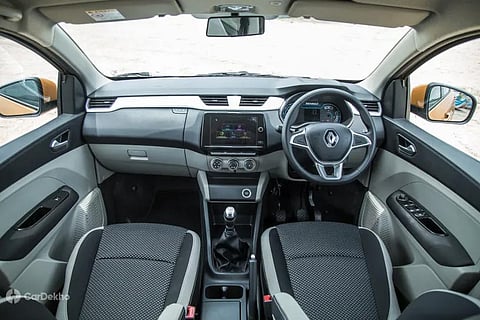
The front seats have soft cushioning and should be a relaxing place to be in. However, we wish Renault would’ve offered adjustable front headrests. On a related note, the driver’s seat could also do with a height-adjust feature.
Thankfully, the steering wheel gets tilt-adjust that lets you tailor your driving position better. However, you don’t get any sort of cover on the steering wheel, which makes it feel budget-grade to hold. Same can be said about the switches for the power windows and the stalks for the headlamps and wipers.

The Triber scores in spades in the practicality department. Dual gloveboxes on the dashboard, a deep central glovebox (that’s cooled, no less), a shelf under the air-con controls and ample space in the door pockets ensures there’s more than enough space for our knick-knacks.

But the bigger question is — does the Triber deliver on the promise of being a seven-seater? Yes, it does. But just about. Knee-room in the second row is just about enough for a near six-footer like me to sit behind my own driving position. To make the experience better, the second row slides by 170mm and also has a recline function. Yes, it could do with a little more width inside the cabin as the thick doorpads rob some vital shoulder room on either side.
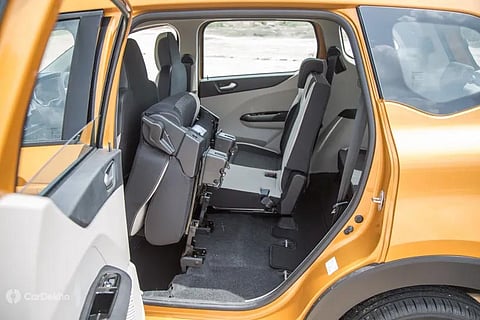
Bumping up the practicality quotient is the 60:40 split for the middle row. For easier access to the third row, the split seat on the passenger’s side also gets a one-touch tumble function. Notably, the other portion of the seat merely slides forward.
Getting in the third row isn’t exactly easy since the opening is quite narrow. But surprisingly, adults will manage to sit here — at least for short distances. The bulge in the roof helps carve out that extra bit of headroom for the third-row occupants. Yes, there’s an evident lack of support for the under-thigh and you end up sitting with the knees near your chest. But, it doesn’t feel uncomfortably cramped. Also, since the second-row slides, it’s possible to find a sweet spot where occupants in both rows are happy with the room.
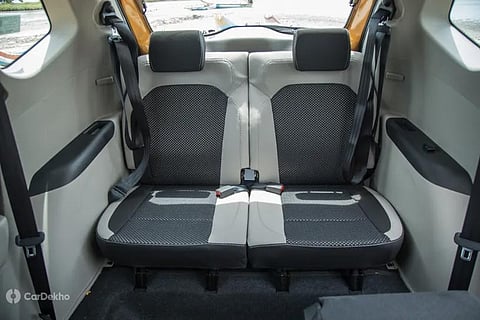
The Triber’s ace is the flexibility of removing the 50:50 third-row seats altogether, should you not need them. Renault calls this EasyFix, and we timed ourselves to see how quickly we could get the third row out to test it out. It takes under two minutes if a single person goes through all the steps, which we think is super quick.
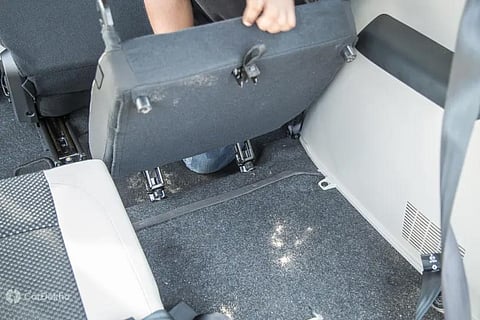
With the rear seats out of the way, the Triber has a whopping 625-litres of bootspace to offer. Using it as a six-seater will get you a 320-litre boot, whereas there’s 84-litres of space with all seven seats occupied.
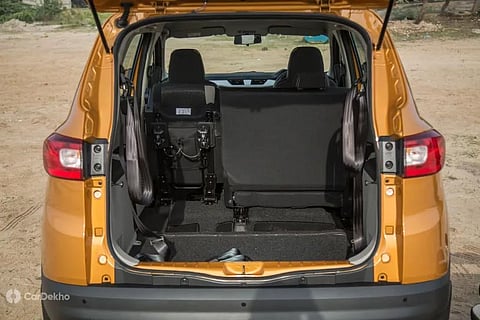
Technology & Features
Renault is offering a smart card type key with the Triber. It’s interesting to note that once the key is within range, the car will unlock by itself — there’s no need to press a button on the key or the door. Walk out of range, and the car will automatically lock too. Handy!
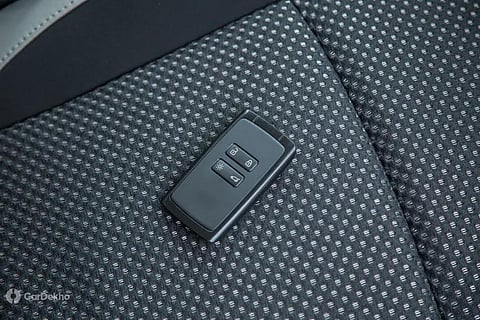
The instrument cluster is an all-digital unit, much like the Kwid, with a 3.5-inch MID in the centre. This small screen is quite informative, including details such as distance to empty, efficiency and fuel used over the usual trip and odo details. It also gets a gear change prompter that, in theory, should help you drive more efficiently.

But there’s a bigger screen that demands attention. Yes, the Triber packs in a large 8-inch touchscreen infotainment system. While we like the screen for its size and clarity, the interface looks old-school and boring, and it isn’t the snappiest to respond to inputs either. There’s a parking camera on offer as well, clarity for which seemed par for the course.

Notably, there’s no automatic climate control on offer, even on the top-spec variant. But that’s hardly going to be a concern on your daily drives. Your fellow passengers would however appreciate the AC vents in the second and third row. The vents are mounted on the B-pillar and the roof respectively and help in cooling the rear of the cabin quickly. You can adjust the fan-speed too by using the dial placed next to the central glovebox.

And that’s another cool feature to have. Literally. The central glovebox gets a cooling feature, which should come in handy to keep those fizzy drinks cold. Other features include a push-button start/stop button, 12V sockets for the second and as well as the third row.

That said, the Triber could do with more. Features such as an auto-dimming rearview mirror, steering-mounted audio/call controls would’ve helped elevate the in-cabin experience.
Performance
The Renault Triber is available with a 1.0-litre, 3-cylinder petrol engine that produces 72PS @ 6250rpm & 96Nm of torque @ 3500rpm. The engine is available with a 5-speed manual transmission as standard with an optional automated manual transmission (AMT). Claimed fuel efficiency figures stand at 20kmpl for the manual and 20.5kmpl for the AMT version.

Safety
Renault is expected to offer dual airbags and ABS with EBD as standard across the range. The top-spec Triber will feature additional side airbags, taking the total tally up to four. The seven-seater is based on the CMF-A platform just like the Kwid. Notably, the vehicle has not been crash-tested by an independent authority, and no NCAP rating is available as of now.
Source: cardekho.com